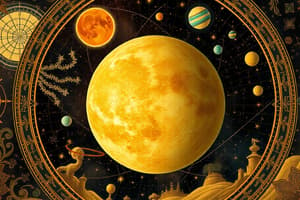Podcast
Questions and Answers
What regulates the paths of the planets in the solar system?
What regulates the paths of the planets in the solar system?
- Gravity from distant stars
- The rotation of the Earth
- Galaxies
- The sun (correct)
Which of the following is NOT covered in the chapter on the solar system?
Which of the following is NOT covered in the chapter on the solar system?
- Causes of living beings’ habitation
- Time difference between Bangladesh and other countries
- History of ancient civilizations (correct)
- Formation of subterranean
Which concept describes the imaginary lines used for time zones?
Which concept describes the imaginary lines used for time zones?
- Planets
- Galaxies
- Ellipses
- Meridians (correct)
What effect does the Earth's diurnal motion have?
What effect does the Earth's diurnal motion have?
What is the significance of the prime meridian in geography?
What is the significance of the prime meridian in geography?
What is the average distance of Mercury from the sun?
What is the average distance of Mercury from the sun?
Which planet has an atmosphere composed of 96% carbon dioxide?
Which planet has an atmosphere composed of 96% carbon dioxide?
How many days does it take Mars to orbit the sun?
How many days does it take Mars to orbit the sun?
What is the main reason for Mercury's high surface temperatures?
What is the main reason for Mercury's high surface temperatures?
Which planet is known to have two natural satellites?
Which planet is known to have two natural satellites?
What is the primary composition of the Sun?
What is the primary composition of the Sun?
Which planet is known for having rings composed of dust and ice particles?
Which planet is known for having rings composed of dust and ice particles?
Which of the following statements about planets in the solar system is true?
Which of the following statements about planets in the solar system is true?
Which is the smallest planet in the solar system?
Which is the smallest planet in the solar system?
What is the distance of the Earth from the Sun?
What is the distance of the Earth from the Sun?
Which planet possesses a dense atmosphere and has a low surface temperature?
Which planet possesses a dense atmosphere and has a low surface temperature?
What is the orbital period of Saturn?
What is the orbital period of Saturn?
How many significant satellites does Neptune have?
How many significant satellites does Neptune have?
Which planet is known for being the largest in the solar system?
Which planet is known for being the largest in the solar system?
What is unique about Earth's atmosphere compared to the other planets mentioned?
What is unique about Earth's atmosphere compared to the other planets mentioned?
What is the role of the ozone layer in the atmosphere?
What is the role of the ozone layer in the atmosphere?
Which gas is essential for plants to perform photosynthesis?
Which gas is essential for plants to perform photosynthesis?
What is the maximum density of the atmosphere located?
What is the maximum density of the atmosphere located?
What average surface temperature does Earth maintain, suitable for living organisms?
What average surface temperature does Earth maintain, suitable for living organisms?
Which factors could negatively impact the atmosphere and environment?
Which factors could negatively impact the atmosphere and environment?
What is the primary composition of the Earth's inner core?
What is the primary composition of the Earth's inner core?
What is the radius of the Earth's outer core?
What is the radius of the Earth's outer core?
Which layer of the Earth is primarily composed of rocks and minerals?
Which layer of the Earth is primarily composed of rocks and minerals?
What is the extent of the Earth's mantle in terms of depth?
What is the extent of the Earth's mantle in terms of depth?
Which of the following elements is abundant in the Earth's crust?
Which of the following elements is abundant in the Earth's crust?
What is the position of the Prime Meridian in terms of longitude?
What is the position of the Prime Meridian in terms of longitude?
How much local time difference corresponds to one degree of longitude?
How much local time difference corresponds to one degree of longitude?
Meridians are essential for determining which of the following?
Meridians are essential for determining which of the following?
What does latitude measure?
What does latitude measure?
Which statement accurately describes the relationship between meridians and the Prime Meridian?
Which statement accurately describes the relationship between meridians and the Prime Meridian?
How is local time at a location determined?
How is local time at a location determined?
What does each degree of longitude correspond to in terms of time difference?
What does each degree of longitude correspond to in terms of time difference?
A location 10° West of Greenwich will be how many minutes behind Greenwich Mean Time (GMT)?
A location 10° West of Greenwich will be how many minutes behind Greenwich Mean Time (GMT)?
What is the significance of the Greenwich Meridian in context to time zones?
What is the significance of the Greenwich Meridian in context to time zones?
Which of the following statements correctly describes Greenwich Mean Time (GMT)?
Which of the following statements correctly describes Greenwich Mean Time (GMT)?
What is the local time determined by?
What is the local time determined by?
If it is noon in Dhaka, how much later is it in Seoul?
If it is noon in Dhaka, how much later is it in Seoul?
What is the standard time for Bangladesh relative to Greenwich Mean Time?
What is the standard time for Bangladesh relative to Greenwich Mean Time?
What is the meridian of Seoul, given that Dhaka is at 90° East?
What is the meridian of Seoul, given that Dhaka is at 90° East?
How many minutes of time difference does one degree of longitude represent?
How many minutes of time difference does one degree of longitude represent?
Which line serves as the reference for measuring longitude?
Which line serves as the reference for measuring longitude?
What shape is the Earth described as in the document?
What shape is the Earth described as in the document?
Why are coordinates important for determining locations on Earth?
Why are coordinates important for determining locations on Earth?
What are meridians?
What are meridians?
What is the primary function of the Equator?
What is the primary function of the Equator?
Which parallels of latitude are significant for climate patterns?
Which parallels of latitude are significant for climate patterns?
How is the Earth's circumference measured for precise location identification?
How is the Earth's circumference measured for precise location identification?
Flashcards
The Universe
The Universe
The vast expanse containing all matter and energy, including stars, galaxies, planets and more. It's incredibly large, billions of times bigger than our solar system.
The Solar System
The Solar System
The Sun, Earth, and other planets and celestial objects orbiting the Sun.
Equator
Equator
The imaginary line that circles the Earth at zero degrees latitude, dividing it into the Northern and Southern hemispheres.
Meridians (Longitude)
Meridians (Longitude)
Signup and view all the flashcards
Diurnal Motion
Diurnal Motion
Signup and view all the flashcards
What is the Sun's role in the solar system?
What is the Sun's role in the solar system?
Signup and view all the flashcards
What are planets?
What are planets?
Signup and view all the flashcards
List the eight planets in the solar system.
List the eight planets in the solar system.
Signup and view all the flashcards
What are the differences between the planets?
What are the differences between the planets?
Signup and view all the flashcards
What keeps the planets in their orbits?
What keeps the planets in their orbits?
Signup and view all the flashcards
Atmosphere
Atmosphere
Signup and view all the flashcards
Troposphere
Troposphere
Signup and view all the flashcards
Tropopause
Tropopause
Signup and view all the flashcards
Ozone Layer
Ozone Layer
Signup and view all the flashcards
Oxygen (O₂)
Oxygen (O₂)
Signup and view all the flashcards
What is Jupiter?
What is Jupiter?
Signup and view all the flashcards
What is Saturn known for?
What is Saturn known for?
Signup and view all the flashcards
What makes Uranus unique?
What makes Uranus unique?
Signup and view all the flashcards
What is Neptune known for?
What is Neptune known for?
Signup and view all the flashcards
What is Earth's atmosphere?
What is Earth's atmosphere?
Signup and view all the flashcards
What is Mercury?
What is Mercury?
Signup and view all the flashcards
What makes Venus the hottest planet?
What makes Venus the hottest planet?
Signup and view all the flashcards
What makes Earth suitable for life?
What makes Earth suitable for life?
Signup and view all the flashcards
Why is Mars called the 'Red Planet'?
Why is Mars called the 'Red Planet'?
Signup and view all the flashcards
What is the Moon's role in Earth?
What is the Moon's role in Earth?
Signup and view all the flashcards
How do geologists study the Earth's interior?
How do geologists study the Earth's interior?
Signup and view all the flashcards
What is the Earth's core made of?
What is the Earth's core made of?
Signup and view all the flashcards
What is the Earth's mantle made of?
What is the Earth's mantle made of?
Signup and view all the flashcards
What is the Earth's crust made of?
What is the Earth's crust made of?
Signup and view all the flashcards
Is the Earth's structure uniform?
Is the Earth's structure uniform?
Signup and view all the flashcards
What is the Equator?
What is the Equator?
Signup and view all the flashcards
What is the Prime Meridian?
What is the Prime Meridian?
Signup and view all the flashcards
What is Longitude?
What is Longitude?
Signup and view all the flashcards
Why are Meridians important?
Why are Meridians important?
Signup and view all the flashcards
What is the relationship between Longitude and Time?
What is the relationship between Longitude and Time?
Signup and view all the flashcards
What are meridians?
What are meridians?
Signup and view all the flashcards
What is local time?
What is local time?
Signup and view all the flashcards
What is Greenwich Mean Time (GMT)?
What is Greenwich Mean Time (GMT)?
Signup and view all the flashcards
What's the time difference?
What's the time difference?
Signup and view all the flashcards
Local Time
Local Time
Signup and view all the flashcards
Standard Time
Standard Time
Signup and view all the flashcards
Time Difference and Longitude
Time Difference and Longitude
Signup and view all the flashcards
Greenwich Mean Time (GMT)
Greenwich Mean Time (GMT)
Signup and view all the flashcards
Dhaka and Seoul Time Difference
Dhaka and Seoul Time Difference
Signup and view all the flashcards
Earth's Axis
Earth's Axis
Signup and view all the flashcards
Prime Meridian
Prime Meridian
Signup and view all the flashcards
Meridians
Meridians
Signup and view all the flashcards
Parallels of Latitude
Parallels of Latitude
Signup and view all the flashcards
Oblate Spheroid
Oblate Spheroid
Signup and view all the flashcards
Tropic of Cancer and Tropic of Capricorn
Tropic of Cancer and Tropic of Capricorn
Signup and view all the flashcards
Arctic Circle and Antarctic Circle
Arctic Circle and Antarctic Circle
Signup and view all the flashcards



